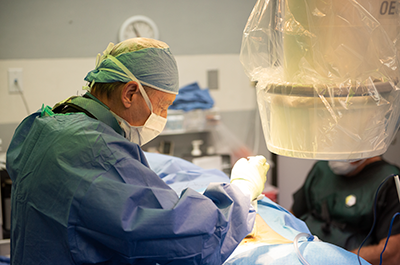Facetectomy
A facetectomy, also called a partial inferior facetectomy, is performed to relieve pressure on spinal nerve roots. Facets are the smooth, flat surfaces of the vertebrae that interlock and allow the spine to flex. Facet joints permit gliding movements between the vertebrae. These joints are in constant motion, providing the spine with the stability and flexibility needed to walk, run, bend, sit and twist. As we age, the cartilage that lines the facet joint surfaces, allowing them to glide easily over one another, gradually wears away, and in many cases growths called bone spurs can develop.

Friction between the bones can cause tenderness, swelling, stiffness and arthritis. This friction also may cause inflammation of the posterior (dorsal) rami (branches or divisions) of the spinal nerves. When these nerves become irritated, they send pain signals in their localized area.
There are a number of terms used to describe facet joint problems, including:
A facetectomy may be utilized to vaporize the dorsal rami nerve fibers that have become inflamed. During this procedure, a small incision is made through which a series of tubes patented by The Bonati Spine Institute are inserted. These tubes accommodate an endoscope and surgical tools, which may include the Holmium laser, which is used to vaporize the nerve fibers. A small portion of the facet bone that is on the nerve may be removed, allowing access to the affected nerve(s). The laser may then be employed to stop the affected nerve from transmitting pain signals from the injured facet joint to the brain.
A facetectomy may be a part of an array of procedures performed by The Bonati Spine Institute. Laminotomy/laminectomy is often performed along with facetectomy to remove a portion of the ligamentum flavum, a ligament in the spinal canal that eventually thickens and compresses the spinal cord, resulting in spinal stenosis. When a portion or a segment of the ligament is removed through laminectomy/laminotomy, the spinal canal is opened, relieving pressure on the nerves. Some patients experience immediate relief during the Bonati Laminotomy as the nerve(s) are released. Because we have decompressed the spinal canal, the patient’s symptoms of neck/back and arm/leg pain are relieved. After the surgery, the patient is encouraged to walk with a companion and is monitored until discharge, returning the next day for a post-operative evaluation.
The Bonati Spine Institute does not use general anesthesia. Through the use of conscious IV sedation and local anesthesia the patient is comfortable, responsive, and able to provide feedback to the doctors throughout the procedure. This allows our surgeons to target the source of pain with pinpoint accuracy. While in the operating room, the surgical team will confirm the patient is able to complete a series of mobility exercises and verify that the pain has been successfully treated. After the procedure, the patient is transferred to the post-operative care unit for rest and observation, and then a post-operative consultation with the surgeon will help determine if additional procedures included in the surgical plan are necessary. Follow-up surgeries are usually scheduled within a few days of the first surgery, to allow any swelling to subside. During this time, the patient will be given a regiment of walking therapy.
